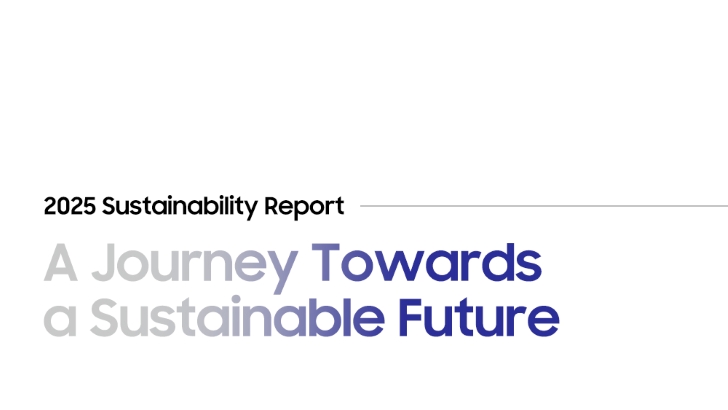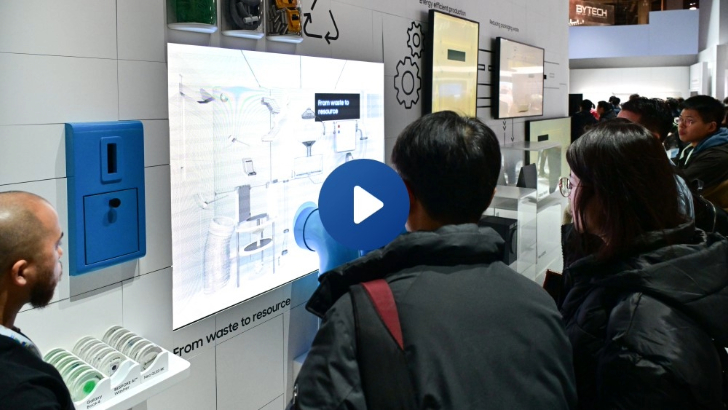Sourcing
Production
Distribution
Using
Recycling
Longer life for the product and
even longer life for the material used
in the product.
We aim to manage resources more sustainably by using
recycled materials and researching methods to extract and
re-use resources from e-waste.


E-waste, born again with
technology
2023 - Ocean-bound plastic recycled and applied to DX products, Circular Economy Lab established / 2024 - 768,000 tonnes of plastic containing recycled materials used cumulatively since 2009 / 2030 - Aim to apply recycled plastic¹) to 50%²) of plastic parts³) in DX products, establish a recycling system for minerals recovered from collected waste batteries / 2050 - Aim to apply recycled plastic¹) to 100%²) of plastic parts³) in DX products


We strive to use recycled materials
in our products.
We are constantly looking for ways to minimize our impact on the land and sea. By focusing on plastic waste as one of the biggest threats to the marine environment, we have developed technology to recycle discarded fishing nets and are continuing our efforts to improve circularity by recycling resources.
Along with the recycled plastic1), rare earth elements2), steel3), and glass4), the Samsung Galaxy S25 Series released in 2025 incorporates new recycled materials such as recycled gold5), copper6), cobalt7), and aluminum8). The Galaxy S25 and S25+ frames also incorporate recycled Armor Aluminum.
In addition, the Galaxy S25 uses recycled cobalt extracted from previously used Galaxy smartphones and batteries discarded during the manufacturing process through Circular Battery Supply Chain. Furthermore, recycled plastics from wafer trays discarded during the semiconductor manufacturing process have been newly applied.
Our efforts to scale the use of recycled materials extend to televisions as well. The graphite sheets of the 2024 and 2025 Neo QLED 8K televisions, used for internal heat dissipation, contain recycled graphite9) extracted from end-of-life batteries.
We are significantly expanding the application of recycled materials in plastic parts used in products — 50% of plastic parts by 2030 and 100% plastic parts (by weight) by 2050.
In 2024, we used 201,755 tonnes of plastics with recycled materials, about 1.3 times more than in 2023.
This is a Double bar chart showing Usage for the current year and Total cumulative usage figures from 2022 to 2024. 2022: Usage for the current year 9.9, Total cumulative usage 40.9 / 2023: Usage for the current year 15.8, Total cumulative usage 56.7 / 2024: Usage for the current year 20.2, Total cumulative usage 76.9.


The use of recycled packaging
materials by product category
Circular Economy Lab
To increase resource circularity, we established Circular Economy Lab at our headquarters to study material recycling technology and product
application. The Circular Economy Lab promotes the replacement of materials in products with recycled materials
and conducts research on waste to resources.
Major areas of research
Get more out of our products


We continue to increase the lifespan of our products because longer lifecycles often mean fewer resources consumed and less carbon emitted.
To reduce the environmental impact of our products, we study and apply ways for our customers to use our products longer.


Extend product life
Products pass tests according to international standards
and meet strict internal standards


Fix and recycle
Easy-to-disassemble design
Easy-to-recycle at the end of the product life


Upgrade
Extended support period for software
upgrades
Modular design so users can use
products that are
tailored to their needs for
longer period of time


Refurbish
Offers customers refurbished and upgraded
smartphones with warranty
Bringing new life
to EOL(End Of Life) products
*Cumulative from 2009


When we switch to a new product, where does the used product end up?
If you think about it, products made from various raw materials are a complex mix of resources. Our e-waste product collection and recycling process allow for e-waste to become ingredients for new products.
From 2009 to 2024, we collected 6.9 million tonnes of waste electronics worldwide through e-waste collection system operated in over 80 countries.
By 2030, we plan to expand the e-waste collection system to all global regions where our products are sold, with the plan to collect a total of 10 million tonnes accumulated since 2009. Furthermore, we also plan to collect 25 million tonnes of e-waste by 2050.
This is a Double bar chart showing Collected amount (current year) and Cumulative collected amount figures from 2022 to 2024. 2022: Collected amount (current year) 59.9, Cumulative collected amount 569.8 / 2023: Collected amount (current year) 59.9, Cumulative collected amount 629.7 / 2024: Collected amount (current year) 61.1, Cumulative collected amount 690.9.


The operation status of
e-waste collection and
recycling programs
We operate various recycling programs in approximately 80 countries around the world, including Korea.
Based on the characteristics of each country, we operate recycling centers directly or cooperate with recycling associations or
companies to operate e-waste recovery
and recycling programs.
* As of 2024

Click a region to see a detailed list
of country/region.































































